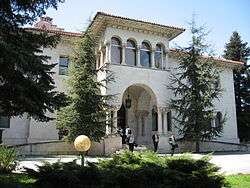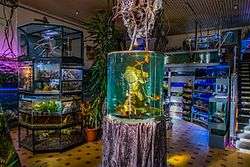Dedinje
Dedinje (Serbian Cyrillic: Дедиње; pronounced [dɛ̌diːɲɛ]) is an urban neighborhood of Belgrade, the capital of Serbia. It is located in Belgrade's municipality of Savski Venac. Dedinje is generally considered the wealthiest part of Belgrade, and is the site of numerous villas and mansions owned by the members of the city's plutocracy, as well as many diplomatic residences.
Dedinje Дедиње | |
|---|---|
 The Royal Palace in Dedinje | |
 Dedinje Location within Belgrade | |
| Coordinates: 44°46′14″N 20°27′24″E | |
| Country | |
| Region | |
| Municipality | Savski Venac |
| Time zone | UTC+1 (CET) |
| • Summer (DST) | UTC+2 (CEST) |
| Area code | +381(0)11 |
| Car plates | BG |
Location
Dedinje is located on the eastern slopes of the hill of Topčidersko Brdo, 7-8 kilometers south of downtown Belgrade to which it is connected by the Kneza Miloša street. It borders the neighborhoods of Senjak (west), Prokop and Mostar (north), Stadion and Diplomatska Kolonija (actually, Dedinje's sub-neighborhood; east), Banjica, Lisičji Potok and Topčider (south). It is well connected to the other parts of Belgrade by several boulevards (of Prince Aleksandar Karađorđević, Vojvoda Putnik) and broad streets (Teodora Drajzera, Neznanog junaka, etc.). Main street in the neighborhood itself is the Užička street.
The hilly section on which the Royal Compound is built is called Vezirovo Brdo ("Vizier's Hill").[1]
History
In Ottoman period, the hill was a gathering place of the Dervishes.[1] Before it was urbanized, the area of modern Dedinje was known for its vineyards, orchards and farms. The area was mentioned by the names Dedija, Mala Dedija, Dedina, Dedino brdo (literally, old man's hill; Serbian deda means old man, grandfather). In Turkish census from 1560, one of the Belgrade's tekije was located there. Austrian army had a camp on Dedinje in 1789 and in their charts from the 18th century they called it Dedinberg. Settlement began to grow after the World War I, intensifying with the building of the residencies of the Karađorđević royal family, from 1924 to 1936. Majority of residents were from the most affluent Belgrade families of industrials, bankers, merchants and politicians, who built summer-houses at first and later lavish villas. What is today considered as the best known parts of Dedinje, like Tolstojeva or Užička streets, were not originally part of the settlement, as it emerged more to the south[2]
Dedinje became popular among Belgrade's rich even before World War II, when it was on the outskirts of the city (thus many military barracks intended to defend the city, which later spawned tens of kilometers further). Many beautiful mansions in green neighborhood have been built, but in 1945 when Communists took over, they declared almost all former residents a state enemies and forced them out of their houses, so the new Communist political and military elite moved in, Tito being among the first. It continued after the collapse of Communism in 1980s, when the nouveau riche politicians (like Slobodan Milošević), shady businessmen (like Karić family or Željko Mitrović) and criminals (like Željko Ražnatović Arkan) moved into the neighborhood and began expanding their villas and erecting high concrete walls. Most of such construction was illegal, often intruding on the property of Dedinje families that had been there for generations preceding the arrival of the nouveau riche/criminal class.
In 2019, Branislav Mitrović, architect and member of the Serbian Academy of Sciences and Arts, said that "caricatural architecture, inept compilations and stylish nonsenses" turned once respectable residential neighborhood of Dedinje, so as Senjak and Neimar, into chaos.[3]
Apart from this, the neighborhood is a site of many embassies, diplomatic residences and some of Belgrade's most expensive restaurants and clubs. In 2013, it was announced that the villa “Crnogorka”, in Uzicka Street, was to be returned to Princess Elizabeth of Yugoslavia. The villa was bought by her mother, Princess Olga, in 1940, and taken by the state in 1947. It is currently owned by the Serbian government and used as the official residence of the Ambassador of Montenegro.[4]
Administration
From June 1945 to December 1946, Dedinje was one of 5 administrative neighborhoods within Belgrade's Raion VII.[5]
Dedinje belonged to the municipality of Topčidersko Brdo, which in 1957 merged with the municipality of Zapadni Vračar to create the municipality of Savski Venac. Dedinje (local communities of Dedinje and 4. Juli) had a population of 8,704 in 2002[6] and 8,440 in 2011.[7]
Notable locations

Politics
- The Royal Compound - location of the Royal Palace and White Palace, official residence of the Karađorđević royal family.
- Presidential residence at Užička 23 and Lackovićeva 10[8][9]
- The embassies of Israel, Pakistan, the United Arab Emirates, Indonesia, China, Korea and the United States.
Culture and science
- The Museum of Yugoslav History
- The House of Flowers, the mausoleum of the late Yugoslav President Josip Broz Tito.
- "Javak - Public Aquarium and Tropicarium" in the Milenka Vesnića street. Adaptation of the facility began in 2014 and it was opened in April 2016 on the location of the former sports hall. It contains aquariums and terrariums with recreated biotopes from all over the world: temperate and tropical waters, forests, rainforests, deserts and cold seas. Part of the exhibition is coordinated with the curriculum of the elementary schools so the Javak can function as the location for the students' practical studies, both from the school and the Faculty of the Veterinarian medicine. There is one large aquarium, 600 m (2,000 ft) long which contains 2,500 l (550 imp gal; 660 US gal) of water. Smaller aquariums are differently shaped - pyramidal, cylindrical, dodecahedron. Javak contains 300 different species. Adriatic aquarium contains crabs, crayfish, octopus, moray eel, sea anemones, sea urchins and starfishes. Tropical and coral aquariums contain fauna from the Hawaiian Islands, Red Sea, Lake Malawi, Lake Tanganyika, Pacific and Indian Ocean. Aquarium for the local fauna include species from the rivers Sava and Danube, and from Sava Lake. Freshwater aquariums are inhabited with the piranhas, Oscar fish, discus fish and arowana. Other maritime organisms include the clownfish, pangasius, common carp, goldfishes, angelfish and sponges. In the Reptil corner, terrariums contain, among others, corn snake, tarantulas, scorpions, geckos, chameleons, agamas, iguanas, gerrhosaurus, red-eared sliders. Additionally, several stray dogs and cats live in the complex. There is also a cinema theatre which shows educational films. Green area around the building is embeslished with the bonsai trees as the nucleus of the projected outdoor artificial pond for the koi fishes, which are now kept inside.[10][11][12] The only public aquarium in Belgrade, by April 2020 the facility hosted some 3,000 individual animals, including the 10 kg (22 lb) large giant gourami. Over 25,000 pupils and students visited the aquarium since it was opened, in organized, educational tours. The facility cooperates with the University of Belgrade's faculties of Biology and Veterinary Medicine, and the Institute for the Natural Protection, including participation in publishing scientific books. The aquarium made news again in 2020 during the coronavirus outbreak, when due to the measures for fighting the pandemic it lost visitors and income, as the costs of specific maintenance and feeding of many exotic species remained high.[13]
Military
- The vast secret military complex of Karaš, built between 1965-1980, with numerous barracks and kilometers of underground passages. Brought to the public's attention
in the 2004 unsolved murders of two on-duty soldiers.[14]
- The headquarters of the Serbian General Staff Guard.
- Military Academy.
Health
- A hospital complex which includes the hospitals of Železnička bolnica and one of the major Belgrade's hospitals, University Hospital Center Dr Dragiša Mišović, whose neonatal nursery ward was notoriously bombed by NATO in 1999, even with the ongoing deliveries.
- Dedinje 1 Hospital Cardio Surgery Hospital. Dedinje 2 hospital is under construction next to older one.
Parks
- Hyde Park, occupying the northern, triangular section of the neighborhood, named after Hyde Park in London.
- Rosalie Morton Park, in the vicinity of the University Hospital Center Dr Dragiša Mišović.
- Playground with a Zip line build by Bakery "Hleb i Kifle", in front of Dragisa Misovic hospital and corner with Street Bulevar Kneza Aleksandra Karadjordjevica
Plantlife
- several old or rare non-native trees protected by the state.[15]
- the cedar tree in the Tolstojeva street, believed to be planted personally by the major Serbian botanist, Josif Pančić, in 1880.
- the tulip tree, between the Pukovnika Bacića and Maglajska streets, native to China and North America, with tulip-like flowers.
- yellow-flowered sophora tree, native to China and Korea.
Sports
- Amateur football club FK Dedinje BGD that plays in Međuopštinska liga "А". Club was formed on February 13th, 2014.
Entertainment
- Headquarters of RTV Pink.
References
- Marija Brakočević (21 May 2014). "Beograd leži na 23 brda" [Belgrade lays on 23 hills]. Politika (in Serbian).
- "Kako je Dedinje dobilo ime?", Politika (in Serbian)
- Branka Jakšić (24 February 2019). "Zavodljive ružne stvari" [Seductive ugly things]. Politika-Magazin, No. 1117 (in Serbian). p. 22.
- "Villa "Crnogorka" Returned To Princess Jelisaveta Karadjordjevic". In Serbia.
- Milić F. Petrović (4 June 2008). "Administrativno-teritorijalna pripadnost" [Administrative and territorial affiliation] (in Serbian). City Municipality of Voždovac.
- Popis stanovništva po mesnim zajednicama, Saopštenje 40/2002, page 4. Zavod za informatiku i statistiku grada Beograda. 26 July 2002.
- Stanovništvo po opštinama i mesnim zajednicama, Popis 2011. Grad Beograd – Sektor statistike (xls file). 23 April 2015.
- "Toma čeka da se Tadić iseli" (in Serbian). Večernje novosti. 12 July 2012. Retrieved 7 July 2013.
- "Vlada Srbije ima devet luksuznih objekata" (in Serbian). Blic. 31 March 2011. Retrieved 7 July 2013.
- "Otvoren javni akvarijum i tropikarijum u Beogradu" (in Serbian). Radio Television Serbia. 19 July 2016.
- Slavica Stuparušić (7 May 2017), "Neobični stanovnici Dedinja - akvarijumske ajkule i ribe sreće", Politika-Magazin No. 1023 (in Serbian), pp. 19–21
- Neda Kurjački (26 July 2016). "Akvarijum i tropikarijum Beograđanima na dar" (in Serbian). N1.
- Ana Vuković (9 April 2020). "Javni akvarijum i tropikarijum ostaje bez hrane" [Public aquarium and tropicarium left with no food]. Politika (in Serbian). p. 16.
- "Karaš još misterija" (in Serbian). Večernje novosti. 2 September 2010. Retrieved 7 July 2013.
- B. Vasiljević (26 April 2008). "Vekovi u krošnjama" (in Serbian). Politika. Retrieved 7 July 2013.
External links
| Wikimedia Commons has media related to Dedinje. |